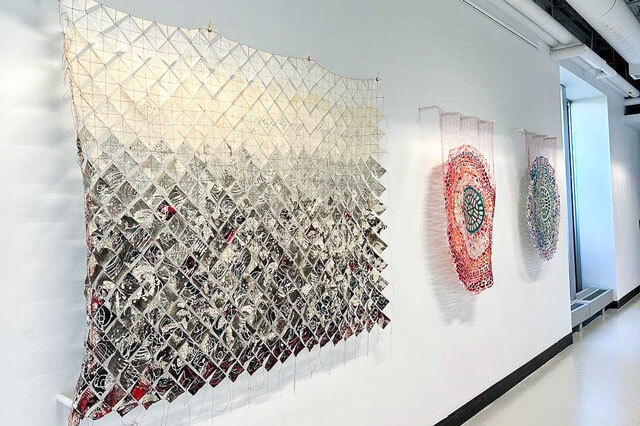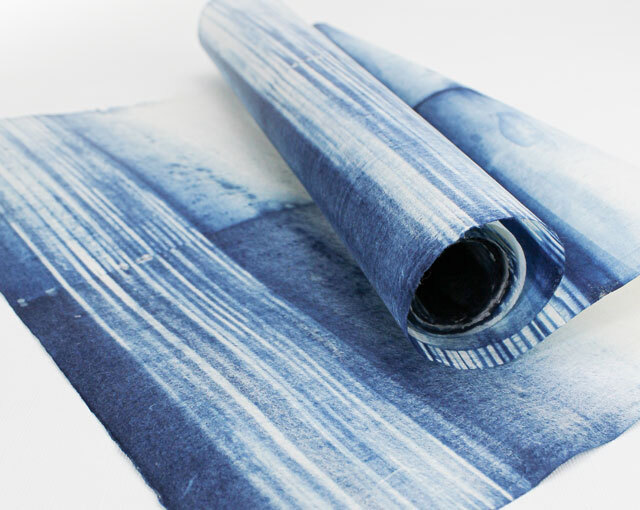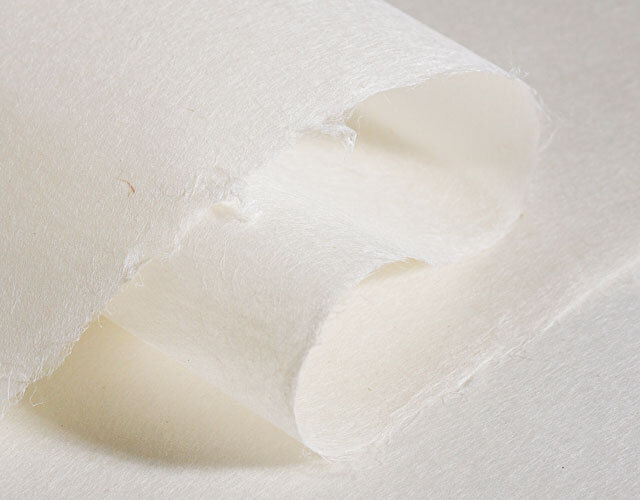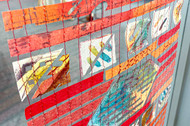Washi and the Fibre Arts
2025 Aug 18th
When it comes to washi, the real question isn’t “What can you do with it?”, but “What can’t you do with it?” Printing and dyeing? Yes. Folding and stitching? Yes. Spinning and weaving? Also, yes! It is easy to see that washi shares many characteristics with textiles; characteristics that the user can readily utilize in myriad ways.
Including hand-stitched elements to work on paper is becoming increasingly popular. Often a thick and sturdy card stock or a heavy cotton rag might come to mind. But think again, what about washi? With its amazing durability and strength, it is a natural choice for stitched work.

Loretta Faveri's paper tapestries at the World of Threads Festival in 2023
Stitching as a means to embellish a print or a drawing can be used to great effect. In an appliqué process, layers of your favourite gampi or mitsumata tissue can add tonal and textural interest to the surface when stitched to a base layer.

Pocket tissue holder made with konnyaku-treated washi by Hilde Goedleven
Treating washi with Konnyaku changes the textural quality of the paper, adding resilience and a slight water resistance. Brushed with konnyaku paste and crumpled, washi becomes momigami, and the increased strength and flexibility allows for sewing, even using a sewing machine, to create small pouches and draperies. Any washi with a high-kozo content, especially unsized papers can be used. Kozo fibre provides the wet-strength necessary for this practice. In Japan, historically, some clothing was made with konnyaku-treated washi. This toughened paper is an excellent choice for bookbinding and cartonnage; it can even be used as a replacement for book cloth in some instances.

Joomchi samples
From Korea, to create a more textile-like product using washi, comes the craft of Joomchi. Essentially, Joomchi is very similar to the process of wet-felting wool. Simple layers of kozo-fibre washi and water are processed by rolling, beating and kneading until the fibre from all layers of paper become interlocked. The result is a thickened, toughened, but still-malleable washi. Historically, some items of clothing in Korea were made from Joomchi, but now it is primarily artists who use this technique to great creative effect.

Indigo dyed Fukunishi Udagami Long 25g by Sigrid Blohm
As we consider approaches to textile that can also be applied to washi, we cannot overlook dyeing. Washi takes dye beautifully. Many of the dyeing techniques we know evolved from historic Japanese textiles. Consider Orizome (fold dyeing) and Shibori (twist or squeeze dyeing). You can see examples of these techniques in our Chigiri-e Papers for Collage package. Incredible results can be achieved when using Indigo to dye washi, as can be seen in this work by Sigrid Blohm.

It is important to select unsized washi for dyeing, such as Sekishu Banshi Tsuru

Kami-ito skeins by Hiroko Karuno, and shufu mat
The term cloth-like can be used to describe washi, but the only way it can truly become fabric, is after it has been turned into thread, Kami-ito, and woven into cloth, Shifu. Sheets of fine washi are cut into very narrow, continuous strips that are then worked, much like spinning, to create a thread. Shifu can then be used for other textile arts, like crochet or knitting, but it is most commonly woven into shifu.
Have you, or your customers tried any of these techniques? Maybe you have heard of other textile-related treatments that have been used on washi? We’d love to know!
Washi to suggest for:
Stitching
| SKU | Product name | Weight | Size |
|---|---|---|---|
| CON1102 | Sekishu Banshi Tsuru (Large) | 25g | 21 x 29.25" |
| CON12124 | Oguni Fudagami Large | 28g | 25.5 x 39" |
| CON1100 | Mitsumata Tissue Light | 11g | 22 x 27.5" |
| CON11827 | Inshu Gampi 001 | 16g | 25 x 38.5" |
| TIS1820 | Gampi Tissue Light Green | 15g | 25 x 37" |
| - | Kizuki Somegami - Various colours | 18g | 25 x 38" |
Konnyaku
| SKU | Product name | Weight | Size |
|---|---|---|---|
| CSS10448 | Konnyaku Powder - 50g | 50g | - |
| NAT7658 | Nishi Kaji Natural | 25g | 24 x 39" |
| TIS1799 | Unryu Kozo White | 25g | 24 x 38" |
| - | Moriki Kozo - Various Colours | 45g | 25 x 37" |
Joomchi
| SKU | Product name | Weight | Size |
|---|---|---|---|
| NAT1270 | Usu Kuchi Heavy 31g | 31g | 25 x 37" |
| CON7625 | Seichosen Kozo Long | 35g | 25.5 x 70.5" |
| CHR2137 | Kinari Chiri | 16g | 25 x 37" |
| CON1110 | Kurotani #16 Small | 25g | 21.5 x 29.25" |
Dyeing
| SKU | Product name | Weight | Size |
|---|---|---|---|
| NAT1270 | Usu Kuchi Heavy 31g | 31g | 25 x 37" |
| CON1102 | Sekishu Banshi Tsuru (Large) | 25g | 21 x 29.25" |
| NAT7658 | Nishi Kaji Natural | 25g | 24 x 39" |
| CON1206 | Fukunishi Udagami Long 40g | 40g | 12.5 x 57" |
Kami-Ito & Shifu
| SKU | Product name | Weight | Size |
|---|---|---|---|
| CON11686 | Inshu Kozo 003 | 17g | 24.75 x 39" |
| CON1110 | Kurotani #16 Small | 25g | 21.5 x 29.25" |
Header image: Take risks, transform by Loretta Faveri, monotype prints on Kozuke and Kizuki Kozo, cut and stitched together.

